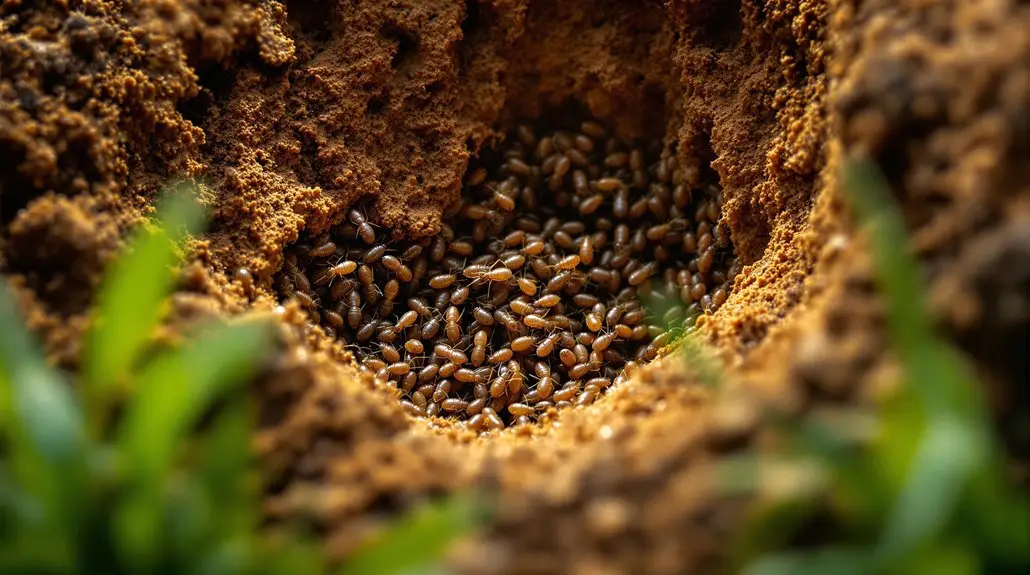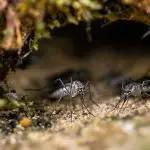Research by Thomas Chouvenc shows that fipronil-treated soils create a death zone that minimizes impacts on subterranean termite colonies, particularly *Coptotermes gestroi*. This zone limits the spread of fipronil, leading to a significant reduction in mortality rates among termites as they alter their foraging behavior. Specifically, the death zone stabilizes around 40 days post-treatment, causing termites to avoid areas with dead nestmates, which negates transfer effects to surrounding colonies. Consequently, this localized approach helps maintain colony health despite initial chemical exposure, suggesting the need for further investigation into pest control strategies. More insights can enhance understanding of these dynamics.
Key Insights
- Fipronil creates a localized death zone, significantly reducing termite mortality beyond 1.5 meters from the treatment area.
- The average death zone extends 1.1 meters at 1.5m and stabilizes around 2.56 meters at greater distances.
- Termites exhibit behavioral avoidance, closing foraging tunnels near treated areas to limit exposure to fipronil.
- Most mortality occurs shortly after exposure, with minimal transfer effects among nestmates due to the death zone dynamics.
- Long-term impacts on colony health remain largely unaffected, necessitating alternative pest management strategies.
Study Overview

In this study, researchers set up controlled laboratory experiments to investigate the effects of fipronil on subterranean termite colonies, specifically *Coptotermes gestroi*. The experimental setup involved specially constructed 3×15 meter foraging arenas designed to simulate natural termite foraging behavior.
In these arenas, whole colonies of *Coptotermes gestroi* were monitored over a period exceeding 200 days, allowing researchers to observe both immediate and long-term effects of fipronil application. Fipronil was applied at distances of 1.5m, 7.5m, and 12.5m from the central nests, using a concentration of 0.06%.
Throughout the experiments, researchers carefully recorded mortality rates and population sizes across different treatment distances. They found that colonies situated only 1.5m from the treatment exhibited a mortality rate of approximately 23.5%, while those at 7.5m and 12.5m experienced considerably lower mortality rates, as low as 1.5%.
Despite these initial impacts, the overall population size of termite colonies exposed to fipronil showed no significant difference compared to control colonies. Additionally, the termites demonstrated remarkable behavioral adaptations; they actively avoided treated areas, opting to use alternative foraging galleries instead. This behavioral response contributed to the colonies’ ability to maintain their long-term foraging potential despite the presence of fipronil, suggesting that while the chemical had some immediate effects, its overall impact on the colonies’ viability was limited. Furthermore, the establishment of a death zone around treated areas may have influenced the termites’ foraging behavior, further minimizing the chemical’s effectiveness. To enhance protection against such infestations, regular professional termite inspections are recommended as part of a comprehensive pest management strategy.
Death Zone Dynamics
The dynamics of the death zone created by fipronil-treated soils reveal considerable behavioral changes in termite colonies. This zone forms at varying distances from the treated soil, averaging approximately 1.1 meters for colonies located 1.5 meters away, while colonies situated at distances of 7.5 and 12.5 meters show an average death zone of about 2.56 meters. Remarkably, the death zone stabilizes roughly 40 days after treatment, establishing an area of avoidance due to the accumulation of deceased individuals, which prompts secondary repellency among surviving termites.
As a result of this avoidance behavior, termites actively close foraging tunnels within a distance of 3 to 5 meters from the treatment area. The necrophobic behavior exhibited by termites further contributes to this phenomenon, as they tend to steer clear of areas where dead nestmates are present. Consequently, the death zone greatly alters foraging patterns, effectively preventing additional exposure to toxicants among the wider termite population. Additionally, the limited impact on subterranean termite colonies in the southern U.S. highlights the challenges posed by liquid insecticides in achieving effective control.
Moreover, despite the challenges posed by the death zone, colonies continue their foraging and reproductive activities in nearby areas over time. The implications for treatment methods are significant; the presence of the death zone suggests that the combination of liquid termiticides and bait stations may not yield the expected effectiveness.
Bait stations positioned within the death zone may experience reduced efficacy due to the repellent effects of the surrounding area. These findings signal a need for further fieldwork to thoroughly assess the impact of the death zone on termite control strategies. Additionally, the placement of subterranean termite baiting stations should be carefully considered to minimize exposure to repellent effects and maximize termite interaction. Field studies are essential to determine optimal station positioning and enhance overall treatment success. Understanding how the death zone influences subterranean termite baiting stations will help refine control strategies for greater long-term effectiveness.
Impact on Termite Mortality

Mortality rates among termite colonies reveal a complex interplay between distance from fipronil-treated soils and the resultant death zone. Colonies situated 1.5 meters away from the treatment exhibit mortality rates as low as 23.5%, while those located at distances of 7.5 meters and 12.5 meters show even lower rates, with mortality dropping to just 1.5% by 200 days post-treatment.
Most mortality occurs during the initial few days following exposure, indicating that the impact is largely confined to this early period. The rapid emergence of the death zone not only limits additional mortality but also prevents further transfer effects among nestmates, as termites tend to avoid areas where cadavers accumulate and the scent of death lingers. This functional repellent zone stabilizes approximately 40 days after treatment, effectively minimizing any ongoing mortality. The spatial reach of this zone extends up to 2.56 meters from the treated area, but for colonies closer to the treatment, such as those 1.5 meters away, the death zone is notably reduced to around 1.1 meters.
Despite the initial spike in mortality, the long-term impact on termite populations remains minimal. Subterranean termite colonies can continue their life cycles and reproduce, maintaining their potential for damage in surrounding areas. This resilience highlights the importance of proactive measures to manage termite infestations effectively. Implementing pre construction termite services can help prevent colonies from establishing in the first place, reducing the risk of long-term structural damage. By integrating these treatments during the early stages of construction, property owners can create a more durable defense against future termite activity.
To summarize, while fipronil treatment can lead to short-term mortality among nearby colonies, the overall health and functionality of termite populations in the long run are largely unaffected.
Fipronil Mechanism Explained
Understanding how fipronil works is essential for grasping its impact on termite populations. Fipronil disrupts the insect central nervous system by blocking ligand-gated ion channels, specifically targeting the GABA A receptor and glutamate-gated chloride (GluCl) channels. This blockage prevents chloride ion channels from opening, which ultimately reduces chloride ions’ ability to lower a neuron’s membrane potential. As a result, an overabundance of neurons reaches action potential, leading to hyperexcitation and central nervous system toxicity due to overstimulation.
The mechanism of fipronil is primarily inhibitory, yet its action induces uncontrolled excitability in the pathways regulated by GABA and glutamate-gated chloride channels. Importantly, fipronil exhibits high selectivity for insect GABA chloride channels that are absent in mammals, which explains its targeted action against invertebrate pests. Studies indicate that fipronil’s environmental persistence can lead to significant impacts on non-target species, showcasing the need for careful application.
Insects display a binding affinity for fipronil that’s considerably greater than that of mammals, making them 700 to 1300 times more sensitive to the compound. Fipronil’s metabolites, such as fipronil sulfone, maintain this selectivity, further enhancing its effectiveness against insects while minimizing potential harm to mammals, including pets.
Although fipronil is stable under normal conditions, it can degrade in the presence of sunlight or metal ions. Understanding this mechanism provides insight into how fipronil effectively controls termite populations while ensuring protection for non-target species.
Implications for Pest Control

Recognizing the implications for pest control is essential when considering fipronil-treated soils. Research shows that while fipronil treatments can effectively protect structures from subterranean termites, their impact on nearby colonies is considerably limited. Mortality among termite colonies decreases dramatically beyond the initial exposure period, with only a small percentage of termites dying after 200 days if they’re located further away from the treatment area. This indicates that the death zone created by the fipronil minimizes the overall impact on colony health and productivity, allowing foraging and reproductive activities to continue despite some losses.
Moreover, termites exhibit behavioral changes due to the death zone, as they tend to avoid areas where dead nestmates accumulate, thereby limiting further exposure to the toxicant. This secondary repellency reduces the likelihood of fipronil spreading to other colonies, reinforcing the treatment’s localized effectiveness. Additionally, fipronil’s nonrepellent properties suggest that termites may not detect its presence until it’s too late, further complicating the dynamics of colony interactions. NaturePest employs organic pest control methods that focus on prevention and non-chemical control, which could complement the limitations of chemical treatments.
However, this implies that pest control strategies may need to adapt; for instance, bait stations installed too close to treated areas could become less effective due to the avoidance behavior of termites.
While fipronil treatments serve as a barrier against termite encroachment, the limited impact on entire colonies raises questions about the sustainability of such liquid termiticides for long-term pest management. As a result, more extensive field studies are necessary to assess the real-world implications of fipronil use, particularly considering the varying foraging distances and colony locations that can influence treatment effectiveness.
Frequently Asked Questions
What Are the Long-Term Effects of Fipronil on Termite Colonies?
Long-term effects of fipronil on termite colonies show minimal mortality, even when colonies are close to treated areas.
Research indicates that colonies can experience as little as 23.5% mortality from nearby treatments, allowing them to maintain population levels.
Additionally, despite some loss of foragers, colonies continue foraging and reproductive activities nearby.
The overall impact on termite populations remains low, highlighting the complexity of chemical treatments in managing termite infestations effectively. This suggests that relying solely on chemical treatments may not be sufficient to control termite colonies in the long term. Understanding termites and their impact on structures and ecosystems is crucial for developing more effective and sustainable management strategies. Integrating chemical treatments with other preventive measures, such as habitat modification and biological control, could enhance overall effectiveness.
How Does Termite Necrophobia Affect Colony Behavior?
Termite necrophobia considerably influences colony behavior, as termites actively avoid areas where dead nestmates accumulate.
This avoidance shapes their foraging patterns, leading to changes in movement and access to resources. The presence of deceased individuals triggers undertaker behavior, where termites remove corpses to maintain hygiene and prevent disease spread.
Consequently, this behavior not only impacts individual termite activity but also affects the overall health and dynamics of the colony, promoting survival and efficiency.
Can Fipronil Resistance Develop in Termite Populations?
Currently, there’s no direct evidence suggesting that fipronil resistance has developed in termite populations.
Researchers note that the rapid mortality caused by fipronil, particularly within the treatment area, minimizes the exposure of termites to the chemical, potentially limiting the opportunity for resistance to build.
Additionally, since fipronil doesn’t transfer effectively beyond a short distance from treated soils, this lack of exposure could hinder the evolutionary pressures needed for resistance development.
What Alternative Treatments Exist for Termite Control?
When considering alternative treatments for termite control, you can explore various natural and chemical methods. Options include neem oil, clove oil, and diatomaceous earth, which effectively target termites while being secure for humans and pets.
Chemical treatments like borates and fipronil are also common, but you might prefer using heat or cold treatments, as well as bait stations, which offer long-term solutions by disrupting termite colonies at their source.
How Do Environmental Factors Influence Fipronil Effectiveness?
Environmental factors greatly influence fipronil’s effectiveness by affecting its persistence and toxicity in various ecosystems.
For instance, increased temperatures can enhance fipronil’s toxicity, particularly among freshwater organisms, while its solubility in river water limits its effectiveness in aquatic environments.
Additionally, soil composition and microbial activity impact fipronil’s degradation rates, determining how long it remains active.
Understanding these variables is essential for optimizing termite control strategies and minimizing environmental risks associated with fipronil use. By evaluating different termite control methods, researchers can identify the most effective approaches while reducing unintended harm to non-target organisms. Integrated pest management strategies that incorporate these methods can enhance long-term effectiveness and sustainability. Additionally, ongoing monitoring and adjustments help ensure that termite control methods remain both efficient and environmentally responsible.
Final Thoughts
Understanding the “Death Zone” Concept
To summarize, while fipronil-treated soils pose a threat to subterranean termite colonies, the emergence of the “death zone” concept reveals a counterintuitive strategy that mitigates this impact by negating transfer effects. Researchers have demonstrated that understanding these dynamics can not only improve pest control methods but also highlight the intricate balance within ecosystems, where the very substances designed to eliminate pests can inadvertently foster resilience. Consequently, the implications of this study extend beyond immediate pest management strategies.
Unleashing Nature’s Resilience: A New Era in Pest Control
Are you dealing with termite issues in South Florida? It’s time to rethink your approach! Embrace the science behind the “death zone” and discover how NaturePest Holistic Pest Control can help you manage pests effectively while respecting the delicate balance of our ecosystems. Join us in creating a sustainable solution for your pest problems today!



